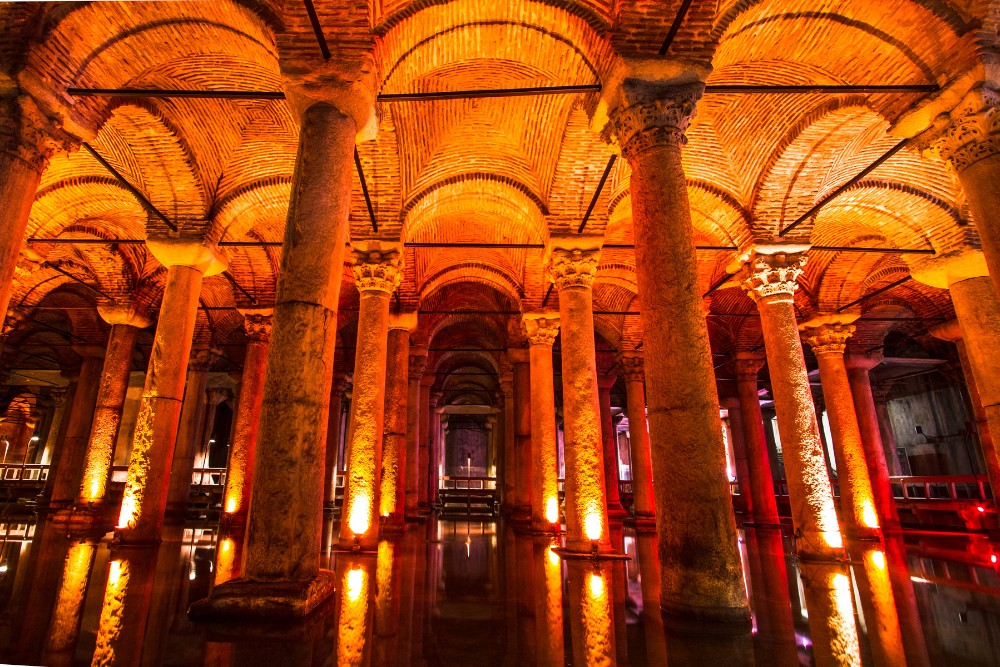The Mysterious Underground Palace of Istanbul
Anasayfa | Blog
Istanbul, a city rich in history and culture, has been a home to many civilizations over the centuries. Among its many treasures, the Basilica Cistern, located in the heart of Sultanahmet, stands out with its unique beauty and historical significance.
Basilica Cistern, situated beneath Sultanahmet Square, was constructed in the 6th century by Byzantine Emperor Justinian I. This massive underground water reservoir covers an area of 9,800 square meters and can hold up to 100,000 tons of water. Supported by 336 marble columns, it captivates visitors with its grandeur and architectural marvel.
May like also: Discovering the Splendor of Topkapi Palace
History and Construction of the Cistern
The construction of the Basilica Cistern took place during one of the most glorious periods of the Byzantine Empire. Commissioned by Emperor Justinian I in the 6th century, this massive underground structure was designed to solve the water supply issues of Constantinople, particularly during sieges and periods of drought. The primary purpose of the cistern was to provide water to the Great Palace of Constantinople, ensuring that the city could maintain its daily functions and sustain its population even in the face of adversity. This monumental project reflected the advanced engineering skills and the strategic foresight of the Byzantine rulers.
The columns used in the construction of the Basilica Cistern were sourced from various ancient structures, a practice that highlights the resourcefulness and recycling efforts of the time. These repurposed columns were meticulously arranged to create a visually stunning and structurally sound reservoir. The sheer scale of the cistern, with its capacity to hold 100,000 tons of water, underscores the significance of water management in ancient cities and the lengths to which the Byzantines went to secure their capital’s water supply. The construction of the cistern not only addressed practical needs but also demonstrated the empire's architectural prowess and dedication to monumental building projects.
Architectural Features of the Basilica Cistern
The Basilica Cistern derives its name from the large number of columns that support its roof, creating a forest-like appearance beneath the city. Each of the 336 columns stands 9 meters tall, with a diameter of 4.8 meters, and they are arranged in 12 rows of 28 columns each. This meticulous arrangement and uniformity create a mesmerizing symmetry, contributing to the cistern's serene and almost otherworldly atmosphere. The columns themselves showcase a variety of architectural styles, including Ionic, Corinthian, and Doric, reflecting the eclectic nature of the materials sourced from different ancient sites.
One of the most intriguing features of the cistern is the presence of two Medusa heads used as column bases. These heads, positioned upside down and sideways, add a touch of ancient mythology and mystery to the site. The origin of these heads and their purpose remains a topic of speculation and intrigue, with some believing they were used simply as practical building materials, while others suggest they were deliberately placed to ward off evil spirits. This blend of functionality and mythological symbolism enhances the Basilica Cistern's allure, making it not just a marvel of engineering but also a repository of ancient legends and artistic expression.
A Jewel in the Heart of Sultanahmet
Sultanahmet is one of Istanbul's most significant historical and tourist districts. Surrounded by landmarks such as the Hagia Sophia, the Blue Mosque, and Topkapi Palace, Sultanahmet is a magnet for both local and international tourists. The Basilica Cistern, located at the heart of this area, shines as a jewel of historical and cultural richness.
The Modern-Day Significance of the Basilica Cistern
Today, the Basilica Cistern serves as a major tourist attraction and a venue for various cultural events. Concerts, exhibitions, and other activities held within the cistern provide visitors with unforgettable experiences. Additionally, the fish swimming in the water and the play of light on the water's surface add to the enchanting atmosphere.
Visiting the Basilica Cistern
For those planning to visit the Basilica Cistern, here are a few tips:
- The cistern is open to visitors every day of the week, but it can get crowded during peak tourist seasons.
- Since it is located in Sultanahmet Square, you can plan a tour that includes other historical sites in the area.
- Photography is allowed inside the cistern, so don't forget to bring your camera to capture the stunning scenery.
The Basilica Cistern holds a special place among Istanbul's historical and cultural treasures. Located in the heart of Sultanahmet, this unique structure amazes visitors with its historical significance and architectural splendor. If you ever find yourself in Istanbul, a visit to the Basilica Cistern is a must. This mysterious underground palace promises unforgettable memories and a journey back in time.


